标签:注入属性 统一 Opens for 接口 零配置 好处 rod 代理模式

spring:春天------给软件行业带来春天!
(Spring Framework Documentation(官方文档):https://docs.spring.io/spring/docs/5.2.6.RELEASE/spring-framework-reference/)
(Spring Framework 5.2.6.RELEASE API(API文档):https://docs.spring.io/spring/docs/5.2.6.RELEASE/javadoc-api/)
(官方下载地址:https://repo.spring.io/release/org/springframework/spring/)
(GitHub:https://github.com/spring-projects/spring-framework)
Spring理念:使现有的技术更加容易使用,本身是一个大杂烩,整合了现有的技术框架!
SSH:Struct2+Spring + Hibernate
SSM:SpringMVC+Spring+MyBatis
依赖:
<!-- https://mvnrepository.com/artifact/org.springframework/spring-webmvc -->
<dependency>
<groupId>org.springframework</groupId>
<artifactId>spring-webmvc</artifactId>
<version>5.2.0.RELEASE</version>
</dependency>
<!-- https://mvnrepository.com/artifact/org.springframework/spring-jdbc -->
<dependency>
<groupId>org.springframework</groupId>
<artifactId>spring-jdbc</artifactId>
<version>5.2.0.RELEASE</version>
</dependency>
Spring是一个开源的免费的框架(容器)
Spring是一个轻量级的,非入侵式的框架
控制反转(IOC),面向切面编程(AOP)
支持事务的处理,对框架整合的支持
Spring就是一个轻量级的控制反转(IOC)和面向切面编程(AOP)的框架!
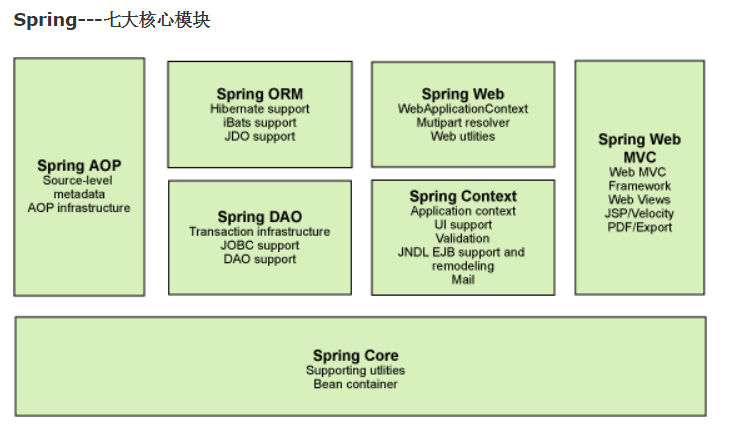
在spring的官网有这个介绍:现代化的java开发!说白了就是基于spring的开发!
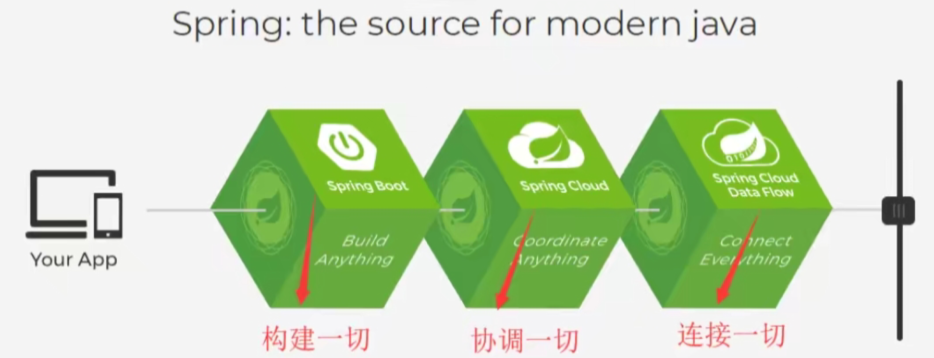
spring Boot
spring Cloud
弊端:发展了太久之后违背了原来的理念!配置十分繁琐,人称“配置地狱”
1、userdao接口
public interface UserDao {
void getUser();
}
2、userDaoImpl实现类
public class UserDaoImpl implements UserDao {
public void getUser() {
System.out.println("默认获取用户的数据");
}
}
3、userService业务接口
public interface UserService {
void getUser();
}
4、userServiceImpl业务实现类
public class UserServiceImpl implements UserService {
private UserDao userDao;
//利用set进行动态实现值的注入
public void setUserDao(UserDao userDao) {
this.userDao = userDao;
}
public void getUser() {
userDao.getUser();
}
}
5、测试
public class MyTest {
@Test
public void getUser(){
//用户实际调用的是业务层,dao层他们不需要接触
UserService userService=new UserServiceImpl();
((UserServiceImpl) userService).setUserDao(new UserDaoImpl());
userService.getUser();
}
}
在我们之前的业务中,用户的需求可能会改变我们原来的代码,我们需要根据用户的需求去修改源代码,如果程序代码量十分大,修改一次的成本价十分昂贵!
我们使用一个set接口实现,已经发生了革命性的变化!
private UserDao userDao;
//利用set进行动态实现值的注入
public void setUserDao(UserDao userDao) {
this.userDao = userDao;
}
之前,程序是主动创建对象,控制权在程序员手上,
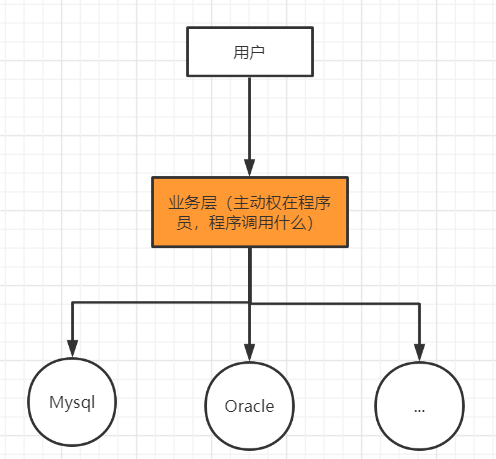
使用了set注入后,程序不再具有主动性,而是变成了 被动的接收对象
这种思想,从本质上解决了问题,程序员不用再去管理对象的创建,系统的耦合性大大降低,可以更加专注的在业务的实现上,这是IOC的原型!
控制反转IOC(Inversion of Control)是一种设计思想,DI(依赖注入)是实现IOC的一种方法
个人认为,所谓的控制反转即:获得 依赖对象的方式反转了
采用xml方式配置Bean的时候,Bean的定义信息和实现是分离的,而采用注解的方式可以把两者合为一体,Bean的定义信息直接以注释的形式定义在实现类中,从而达到零配置的目的。
控制反转是一种通过描述(XML或注释)并通过第三方去生产或获取特定对象的方式,在Spring中实现控制反转的是IOC容器,其实现方法是依赖注入(DI)
1、创建实体类
public class Hello {
private String str;
public String getStr() {
return str;
}
public void setStr(String str) {
this.str = str;
}
@Override
public String toString() {
return "Hello{" +
"str=‘" + str + ‘\‘‘ +
‘}‘;
}
}
2、实例化容器
<?xml version="1.0" encoding="UTF-8"?>
<beans xmlns="http://www.springframework.org/schema/beans"
xmlns:xsi="http://www.w3.org/2001/XMLSchema-instance"
xsi:schemaLocation="http://www.springframework.org/schema/beans
https://www.springframework.org/schema/beans/spring-beans.xsd">
<!-- 使用spring来创建对象,在spring中这些都称之为bean
bean = 对象 new Hello();
id = bean名
class = new 的对象
property 给对象中的属性设置一个值
-->
<bean id="UserDaoImpl" class="com.spring.dao.UserDaoImpl"></bean>
<bean id="MysqlImpl" class="com.spring.dao.UserDaoMysqlImpl"></bean>
<bean id="UserServiceImpl" class="com.spring.service.UserServiceImpl">
<!-- ref:引用spring中创建好的对象
value:具体的值,基本数据类型-->
<property name="userDao" ref="UserDaoImpl"/>
</bean>
</beans>
3、测试
public class MyTest {
@Test
public void getUser(){
ApplicationContext applicationContext = new ClassPathXmlApplicationContext("beans.xml");
UserServiceImpl userServiceImpl = (UserServiceImpl) applicationContext.getBean("UserServiceImpl");
userServiceImpl.getUser();
}
}
现在,要实现不同的操作,只需要在xml文件中间进行修改,所谓的IOC,一句话搞定:对象由Spring来创建,管理,装配!
? 1、通过下标
<!--1.通过下标赋值-->
<bean id="user" class="com.spring.pojo.User">
<constructor-arg index="0" value="123"/>
</bean>
? 2、通过参数类型
<!--2.通过参数类型,不建议使用-->
<bean id="user" class="com.spring.pojo.User">
<constructor-arg type="java.lang.String" value="456"/>
</bean>
? 3、通过参数名
<!--3.直接通过参数名-->
<bean id="user" class="com.spring.pojo.User">
<constructor-arg name="name" value="789"/>
</bean>
总结:在配置文件加载的时候,容器中管理的对象就已经初始化了!
<!-- 如果添加了别名,我们也可以用别名来设置-->
<alias name="user" alias="userNew"/>
User user = (User) applicationContext.getBean("userNew");
<!-- id:bean的唯一标识符
class : bean对象所对应的全限定名:包名+类名
name:也是别名,而且name可以同时取多个别名,通过逗号,分号,空格分隔
-->
<bean id="userT" class="com.spring.pojo.UserT" name="userT2,u2"></bean>
一般用于团队开发,可以将多个配置文件导入合并为一个
<?xml version="1.0" encoding="UTF-8"?>
<beans xmlns="http://www.springframework.org/schema/beans"
xmlns:xsi="http://www.w3.org/2001/XMLSchema-instance"
xsi:schemaLocation="http://www.springframework.org/schema/beans http://www.springframework.org/schema/beans/spring-beans.xsd">
<import resource="beans.xml"/>
<import resource="beans2.xml"/>
<import resource="beans3.xml"/>
</beans>
ApplicationContext applicationContext = new ClassPathXmlApplicationContext("applicationContext.xml");
依赖注入:set注入
? 依赖:bean对象的创建依赖于容器
? 注入:bean对象中的所有属性由容器来注入
【环境搭建】
? 1、复杂类型
public class Address {
private String address;
}
? 2、真实测试对象
public class Student {
private String name;
private Address address;
private String[] book;
private List<String> hobby;
private Map<String,String> card;
private Set<String> games;
private Properties info;
private String wife;
}
3、beans.xml
<?xml version="1.0" encoding="UTF-8"?>
<beans xmlns="http://www.springframework.org/schema/beans"
xmlns:xsi="http://www.w3.org/2001/XMLSchema-instance"
xsi:schemaLocation="http://www.springframework.org/schema/beans http://www.springframework.org/schema/beans/spring-beans.xsd">
<bean id="address" class="com.spring.pojo.Address">
<property name="address" value="西安"/>
</bean>
<bean id="student" class="com.spring.pojo.Student">
<!--第一种:普通值注入,直接使用value-->
<property name="name" value="潘瑞"/>
<!--第二种:bean注入,ref-->
<property name="address" ref="address"/>
<!--数组-->
<property name="book">
<array>
<value>红楼梦</value>
<value>水浒传</value>
<value>三国演义</value>
<value>西游记</value>
</array>
</property>
<!--List-->
<property name="hobby">
<list>
<value>听歌</value>
<value>看电影</value>
<value>敲代码</value>
</list>
</property>
<!--map-->
<property name="card">
<map>
<entry key="身份证" value="123456"/>
<entry key="银行卡" value="635241"/>
</map>
</property>
<!--set-->
<property name="games">
<set>
<value>王者荣耀</value>
<value>LOL</value>
<value>COC</value>
</set>
</property>
<!--null-->
<property name="wife">
<null/>
</property>
<!--Properties-->
<property name="info">
<props>
<prop key="学号">123</prop>
<prop key="性别">男</prop>
<prop key="年龄">16</prop>
</props>
</property>
</bean>
</beans>
4、测试类
public class MyTest {
public static void main(String[] args) {
ApplicationContext applicationContext = new ClassPathXmlApplicationContext("beans.xml");
Student student = (Student) applicationContext.getBean("student");
System.out.println(student.toString());
}
}
/*Student{name=‘潘瑞‘,
address=Address{address=‘西安‘},
book=[红楼梦, 水浒传, 三国演义, 西游记],
hobby=[听歌, 看电影, 敲代码],
card={身份证=123456, 银行卡=635241},
games=[王者荣耀, LOL, COC],
info={学号=123, 性别=男, 年龄=16},
wife=‘null‘}
*/
使用p命名空间和c命名空间注入
1、官方解释:
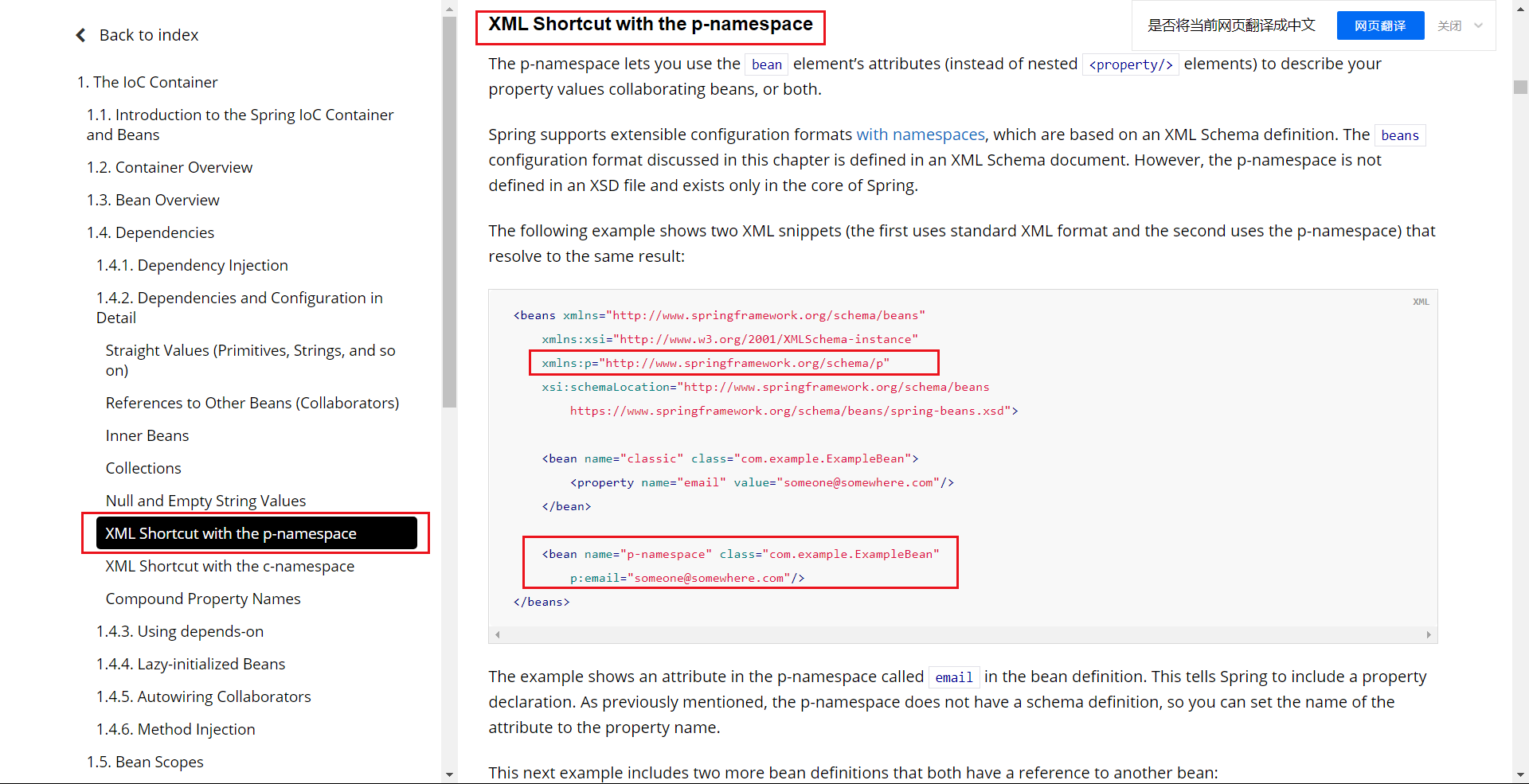
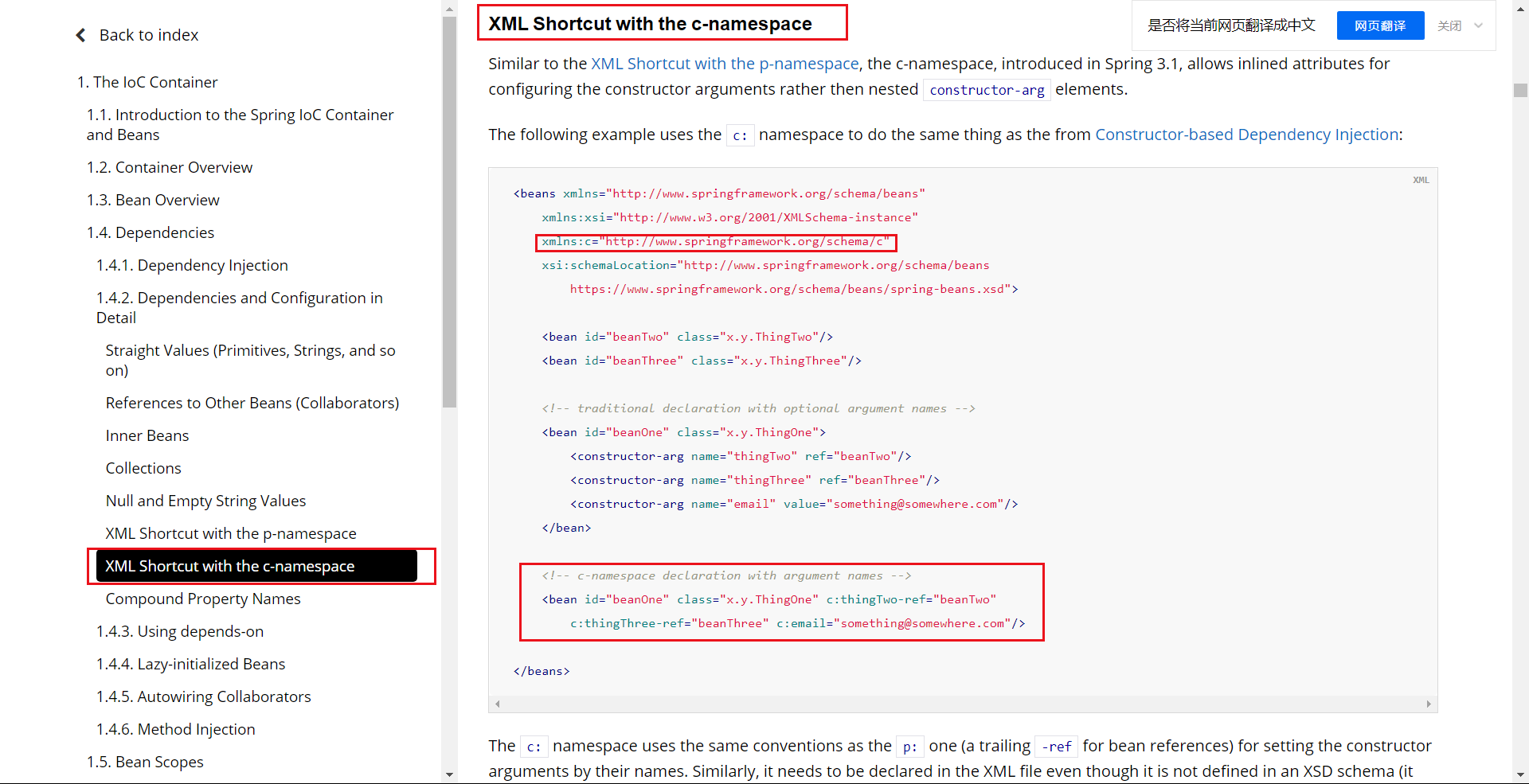
2、使用:
<?xml version="1.0" encoding="UTF-8"?>
<beans xmlns="http://www.springframework.org/schema/beans"
xmlns:xsi="http://www.w3.org/2001/XMLSchema-instance"
xmlns:p="http://www.springframework.org/schema/p"
xmlns:c="http://www.springframework.org/schema/c"
xsi:schemaLocation="http://www.springframework.org/schema/beans http://www.springframework.org/schema/beans/spring-beans.xsd">
<!--p命名空间注入,可以直接注入属性的值:property-->
<bean id="user" class="com.spring.pojo.User" p:name="潘瑞" p:age="23"/>
<!--c命名空间注入,通过构造器参数-->
<bean id="user2" class="com.spring.pojo.User" c:age="18" c:name="李四"/>
</beans>
3、测试:
@Test
public void mytest(){
ApplicationContext applicationContext = new ClassPathXmlApplicationContext("UserBeans.xml");
User user = applicationContext.getBean("user2", User.class);
System.out.println(user.toString());
}
4、注意点:p命名空间和c命名空间不能直接使用,需要导入xml约束!p命名空间使用set注入,c命名空间使用构造器注入
xmlns:p="http://www.springframework.org/schema/p"
xmlns:c="http://www.springframework.org/schema/c"
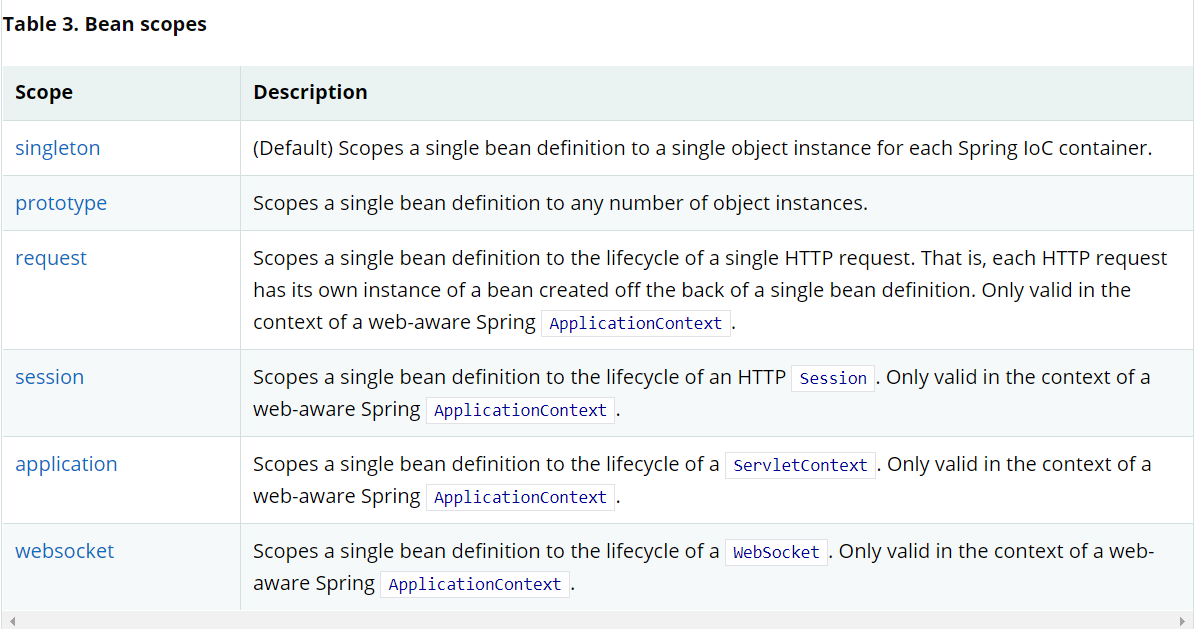
1、单例模式(spring默认机制)
<bean id="user2" class="com.spring.pojo.User" c:age="18" c:name="李四" scope="singleton"/>
2、原型模式:每次从容器中get时都会产生新对象
<bean id="user2" class="com.spring.pojo.User" c:age="18" c:name="李四" scope="prototype"/>
3、其余的request、session、application,这些只能在web开发中使用到!
自动装配是Spring满足bean依赖的一种方式
Spring会在上下文中自动寻找,并自动给bean装配属性!
在Spring中,有三种装配方式
1、在xml中显示配置
2、在java中显示配置
3、隐式的自动装配bean【重要】
环境搭建:一个人有两个宠物
<!--
byName:会自动在容器中查找,和自己对象set方法后面的值对应的beanid!
-->
<bean id="person" class="com.spring.pojo.person" autowire="byName">
<property name="name" value="潘瑞"/>
</bean>
<bean class="com.spring.pojo.Cat"/>
<bean class="com.spring.pojo.Dog"/>
<!--
byName:会自动在容器中查找,和自己对象set方法后面的值对应的beanid!
byName:会自动在容器中查找,和自己对象属性相同的的bean!
-->
<bean id="person" class="com.spring.pojo.person" autowire="byType">
<property name="name" value="潘瑞"/>
</bean>
小结:
? byName的时候,需要保证所有bean的id唯一,并且这个bean需要和自动注入的属性的set方法的值一致!
? byType的时候,需要保证所有bean的class唯一,并且这个bean需要和自动注入的属性的类型一致!
The introduction of annotation-based configuration raised the question of whether this approach is “better” than XML.
要使用注解须知:
? 1、导入context约束
? 2、配置注解的支持 <context:annotation-config/>
<?xml version="1.0" encoding="UTF-8"?>
<beans xmlns="http://www.springframework.org/schema/beans"
xmlns:xsi="http://www.w3.org/2001/XMLSchema-instance"
xmlns:context="http://www.springframework.org/schema/context"
xsi:schemaLocation="http://www.springframework.org/schema/beans
https://www.springframework.org/schema/beans/spring-beans.xsd
http://www.springframework.org/schema/context
https://www.springframework.org/schema/context/spring-context.xsd">
<context:annotation-config/>
</beans>
@Autowired
直接在属性上使用,也可以在set方法上使用!
使用@Autowired,我们可以不用编写set方法,前提是你这个自动装配的属性在IOC(Spring)容器中存在,且符合名字byName!
科普:
@Nullable 字段标记这个注解,说明这个字段可以为null
@Autowired(required = false)
public @interface Autowired {
boolean required() default true;
}
测试:
public class person {
//如果显示的定义了@Autowired(required = false),说明这个对象可以为null,否则不允许为空
@Autowired(required = false)
private Cat cat;
@Autowired
private Dog dog;
private String name;
如果@Autowired自动装配的环境比较复杂,自动装配无法通过一个注解【@Autowired】完成的时候,我们可以使用@@Qualifier(value = "bean id")去配置@Autowired的使用,指定一个唯一的bean对象注入!
@Autowired
@Qualifier(value = "dog222")
private Dog dog;
@Resource
@Resource(name = "cat2")
private Cat cat;
@Resource
private Dog dog;
private String name;
小结:
@Resource和@Autowired的区别:
都是用来自动装配的,都可以放在属性字段上
@Autowired通过byType的方式实现,而且必须要求这个对象存在!【常用】
@Resource默认通过byName方式实现,如果找不到名字,则通过byType实现!如果两个都找不到就报错!【常用】
执行顺序不同:@Autowired通过byType的方式实现,@Resource默认通过byName方式实现
在Spring4之后,要使用注解开发,必须导入aop的包
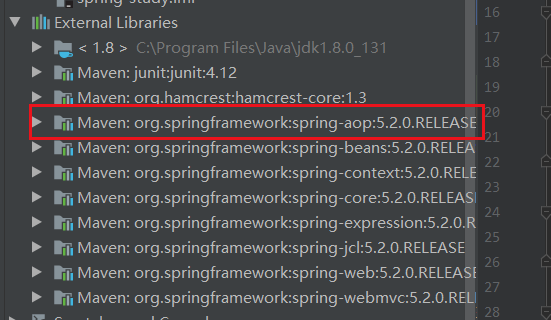
使用注解需要导入context约束,增加注解的支持
<?xml version="1.0" encoding="UTF-8"?>
<beans xmlns="http://www.springframework.org/schema/beans"
xmlns:xsi="http://www.w3.org/2001/XMLSchema-instance"
xmlns:context="http://www.springframework.org/schema/context"
xsi:schemaLocation="http://www.springframework.org/schema/beans
https://www.springframework.org/schema/beans/spring-beans.xsd
http://www.springframework.org/schema/context
https://www.springframework.org/schema/context/spring-context.xsd">
<context:annotation-config/>
</beans>
1、bean
? @Component等价于<bean id="user" class="com.spring.pojo.User"/>
2、属性如何注入
@Component
public class User {
//相当于<property name="name" value="panrui"/>
public String name;
@Value("panrui")
public void setName(String name) {
this.name = name;
}
}
3、衍生的注解
@Component有几个衍生注解,我们在web开发中,会按照mvc三层架构分层!
- dao【@Repository】
- service【@Service】
- controller【@Controller】
- 这四个功能都是一样的,都是代表将某个类注册到Spring中,装配Bean
4、自动装配
5、作用域
@Scope("singleton")//单例
@Scope("prototype")//原型
6、小结
xml与注解:
xml更加万能,适用于任何场合,维护简单方便
注解不是自己的类使用不了,维护相对复杂!
xml与注解最佳实践:
xml用来管理bean
注解只负责完成属性的注入
使用过程中只需要注意一个问题,必须让注解生效,就必须开启注解的支持!
<!--指定要扫描的包,这个报下的注解就会生效-->
<context:component-scan base-package="com.spring"/>
<context:annotation-config/>
我们现在要完全不使用Spring的xml配置,全权交给java来做
javaConfig是Spring的一个子项目,在Spring4之后,他成为了一个核心功能
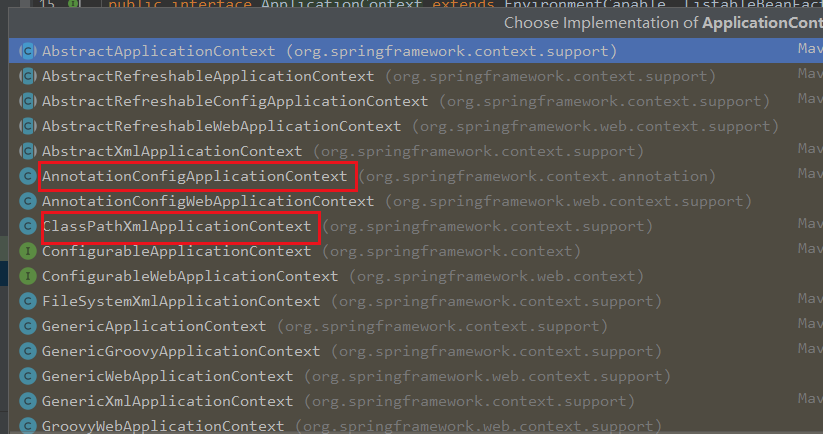
实体类
package com.spring.pojo;
import org.springframework.beans.factory.annotation.Value;
import org.springframework.stereotype.Component;
//这个注解的意思,就是说明这个类被Spring接管了,注册到了容器中
@Component
public class User {
private String name;
public String getName() {
return name;
}
@Value("123")
public void setName(String name) {
this.name = name;
}
@Override
public String toString() {
return "User{" +
"name=‘" + name + ‘\‘‘ +
‘}‘;
}
}
配置类
//这个也会被Spring托管,注册到容器中,因为他本来就是一个@Component
//@Configuration代表这是一个配置类,就和我们之前看的beans.xml一样
@Configuration
@ComponentScan("com.spring.pojo")
public class JavaConfig {
//注册一个bean就相当于我们之前写的一个bean标签
//这个方法的名字就相当于bean标签中的id属性,返回值就相当于class属性
@Bean
public User getUser(){
return new User();
}
}
测试类
public class MyTest {
public static void main(String[] args) {
//如果完全使用了配置了方式去做,我们就只能通过AnnotationConfig上下文来获取容器,通过配置类的class对象加载!
ApplicationContext context = new AnnotationConfigApplicationContext(JavaConfig.class);
User getUser = (User) context.getBean("getUser");
System.out.println(getUser.getName());
}
}
这种纯java的配置方式,贼SpringBoot中随处可见!
为什么学习代理模式?因为这就是SpringAOP的底层!【SpringAOP和SpringMVC】
代理模式的分类:

角色分析:
代码步骤:
1、接口
//租房
public interface Rent {
public void rent();
}
2、真实角色
//房东
public class Host implements Rent {
public void rent() {
System.out.println("房东要出租房子!");
}
}
3、代理角色
//代理
public class Proxy implements Rent{
private Host host;
public Proxy(){}
public Proxy(Host host) {
this.host = host;
}
public void rent() {
host.rent();
seeHouse();
fee();
hetong();
}
//看房
public void seeHouse(){
System.out.println("中介带你看房!");
}
//收中介费
public void fee(){
System.out.println("收中介费!");
}
//签租赁合同
public void hetong(){
System.out.println("签租赁合同!");
}
}
4、客户端访问代理角色
//客户
public class Client {
public static void main(String[] args) {
//房东要租房子
Host host=new Host();
//代理,中介帮房东租房子,但是代理角色一般会有一些附属操作
Proxy proxy = new Proxy(host);
//你不用面对房东,直接找中介租房即可
proxy.rent();
}
}
代理模式的好处:
缺点:
聊聊AOP
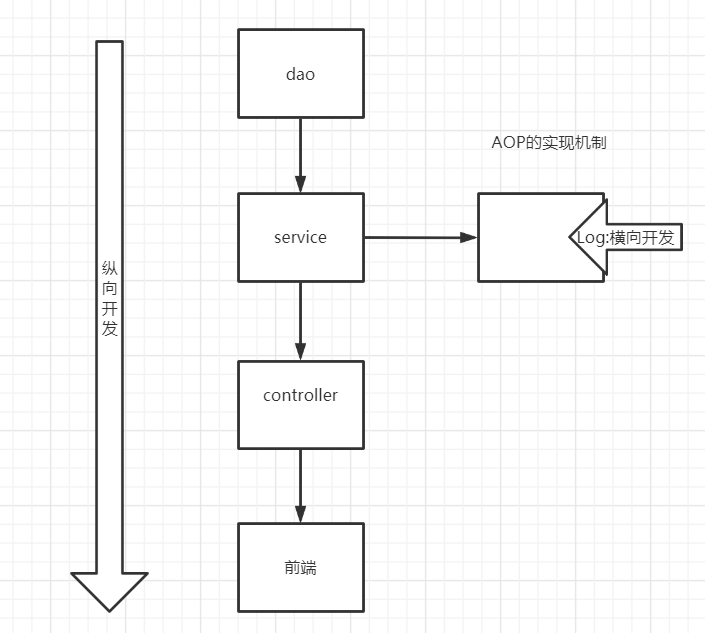
1、接口
public interface UserService {
public void add();
public void delete();
public void update();
public void query();
}
2、真实角色
//真实对象
public class UserServiceImpl implements UserService {
public void add() {
System.out.println("增加了一个用户!");
}
public void delete() {
System.out.println("删除了一个用户!");
}
public void update() {
System.out.println("修改了一个用户!");
}
public void query() {
System.out.println("查询了一个用户!");
}
//1.改动原来的业务代码,在公司中是大忌
}
3、代理角色
public class UserServiceProxy implements UserService {
private UserServiceImpl userServiceImpl;
public void setUserServiceImpl(UserServiceImpl userServiceImpl) {
this.userServiceImpl = userServiceImpl;
}
public void add() {
log("add");
userServiceImpl.add();
}
public void delete() {
log("delete");
userServiceImpl.delete();
}
public void update() {
log("update");
userServiceImpl.update();
}
public void query() {
log("query");
userServiceImpl.query();
}
//日志方法
public void log(String msg){
System.out.println("使用了"+msg+"方法!");
}
}
4、客户端访问代理角色
public class Client {
public static void main(String[] args) {
UserServiceImpl userService=new UserServiceImpl();
UserServiceProxy userServiceProxy=new UserServiceProxy();
userServiceProxy.setUserServiceImpl(userService);
userServiceProxy.add();
}
}
需要了解两个类:
Proxy:代理
InvocationHandler:生成得到代理类,处理代理实例并返回结果
1、接口
//租房
public interface Rent {
public void rent();
}
2、真实角色
//房东
public class Host implements Rent {
public void rent() {
System.out.println("房东要出租房子!");
}
}
3、InvocationHandler类
//自动生成代理类
public class ProxyInvocationHandler implements InvocationHandler {
//被代理的接口
private Object target;
public void setTarget(Object target) {
this.target = target;
}
//生成得到代理类
public Object getProxy(){
return Proxy.newProxyInstance(this.getClass().getClassLoader(),
target.getClass().getInterfaces(), this);
}
//处理代理实例并返回结果
public Object invoke(Object proxy, Method method, Object[] args) throws Throwable {
//动态代理的本质就是使用反射机制
log(method.getName());
return method.invoke(target, args);
}
public void log(String msg){
System.out.println("执行了"+msg+"方法");
}
}
4、客户端访问代理角色
public class Client {
public static void main(String[] args) {
//真实角色
Host host=new Host();
//代理角色
ProxyInvocationHandler proxyInvocationHandler=new ProxyInvocationHandler();
proxyInvocationHandler.setTarget(host);//设置要代理的对象
//动态生成代理类
Rent proxy = (Rent) proxyInvocationHandler.getProxy();
proxy.rent();
}
}
动态代理的好处:
AOP(Aspect Oriented Programming)意为:面向切面编程,通过预编译方式和运行期间动态代理实现程序功能的统一维护的一种技术。AOP是OOP的延续,是软件开发中的一个热点,也是Spring框架中的一个重要内容,是函数式编程的一种衍生范型。利用AOP可以对业务逻辑的各个部分进行隔离,从而使得业务逻辑各部分之间的耦合度降低,提高程序的可重用性,同时提高了开发的效率。
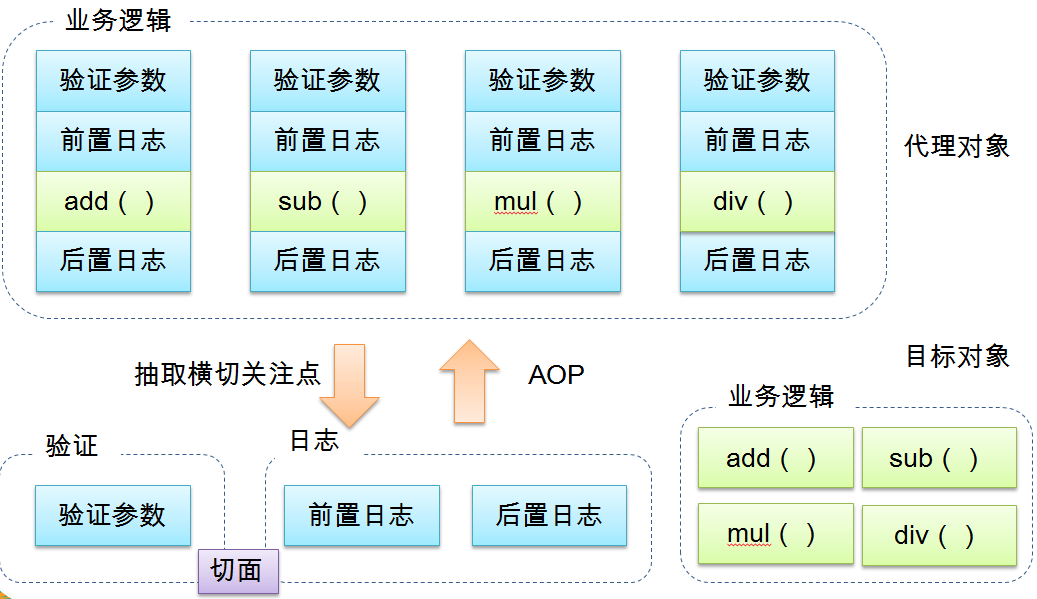
提供声明式事务:允许用户自定义切面
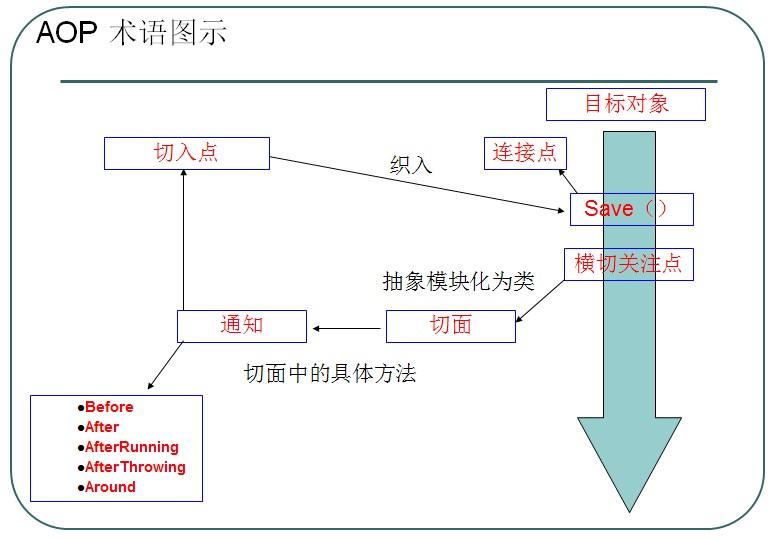
SpringAOP中,通过Advice定义横切逻辑,Spring中支持5中类型的Advice:

即,AOP在不改变原有代码的情况下,去增加新的功能
【重点】使用AOP织入,需要导入一个依赖包
<!-- https://mvnrepository.com/artifact/org.aspectj/aspectjweaver -->
<dependency>
<groupId>org.aspectj</groupId>
<artifactId>aspectjweaver</artifactId>
<version>1.9.4</version>
</dependency>
1、接口
public interface UserService {
public void add();
public void delete();
public void update();
public void select();
}
2、实体类
public class UserServiceImpl implements UserService{
public void add() {
System.out.println("增加了一个用户!");
}
public void delete() {
System.out.println("删除了一个用户!");
}
public void update() {
System.out.println("更新了一个用户!");
}
public void select() {
System.out.println("查询了一个用户!");
}
}
3、织入类
public class Log implements MethodBeforeAdvice {
//method:要执行的目标对象的方法
//args:参数
//target:目标对象
public void before(Method method, Object[] args, Object target) throws Throwable {
System.out.println(target.getClass().getName()+"的"+method.getName()+"被执行了!");
}
}
public class AfterLog implements AfterReturningAdvice {
//returnValue:返回值
public void afterReturning(Object returnValue, Method method, Object[] args, Object target) throws Throwable {
System.out.println("执行了"+method.getName()+"返回结果为:"+returnValue);
}
}
4、applicationContext.xml
<!--注册bean-->
<bean id="UserServiceImpl" class="com.spring.service.UserServiceImpl"/>
<bean id="Log" class="com.spring.Log.Log"/>
<bean id="AfterLog" class="com.spring.Log.AfterLog"/>
<!--方式一:使用原生的Spring API接口-->
<!--配置AOP:需要导入AOP的约束-->
<aop:config>
<!--切入点 :expression表达式 execution(要执行的位置!)-->
<aop:pointcut id="pointcut" expression="execution(* com.spring.service.UserServiceImpl.*(..))"/>
<!--执行环绕增加-->
<aop:advisor advice-ref="Log" pointcut-ref="pointcut"/>
<aop:advisor advice-ref="AfterLog" pointcut-ref="pointcut"/>
</aop:config>
5、测试类
public class MyTest {
public static void main(String[] args) {
ApplicationContext applicationContext = new ClassPathXmlApplicationContext("applicationContext.xml");
//动态代理代理的是接口:注意点
UserService userService = (UserService) applicationContext.getBean("UserServiceImpl");
userService.select();
}
}
1、接口
2、实体类
3、切面
public class DiyPointCut {
public void before(){
System.out.println("-----方法执行前-----");
}
public void after(){
System.out.println("-----方法执行后-----");
}
}
4、applicationContext.xml
<!--方式二:自定义类-->
<bean id="UserServiceImpl" class="com.spring.service.UserServiceImpl"/>
<bean id="diy" class="com.spring.diy.DiyPointCut"/>
<aop:config>
<!--自定义切面,ref要引用的类-->
<aop:aspect ref="diy">
<!--切入点-->
<aop:pointcut id="point" expression="execution(* com.spring.service.UserServiceImpl.*(..))"/>
<!--通知-->
<aop:before method="before" pointcut-ref="point"/>
<aop:after method="after" pointcut-ref="point"/>
</aop:aspect>
</aop:config>
5、测试类
1、接口
2、实体类
3、切面
//使用注解方式实现AOP
@Aspect//标注这个类是一个切面
public class annotation {
@Before("execution(* com.spring.service.UserServiceImpl.*(..))")
public void before(){
System.out.println("方法执行前");
}
@After("execution(* com.spring.service.UserServiceImpl.*(..))")
public void after(){
System.out.println("方法执行后");
}
//在环绕增强中,我们可以给定一个参数,代表我们要获取处理切入的点
@Around("execution(* com.spring.service.UserServiceImpl.*(..))")
public void around(ProceedingJoinPoint jp) throws Throwable {
System.out.println("环绕前");
Object proceed = jp.proceed();//执行方法
System.out.println("环绕后");
}
}
4、applicationContext.xml
<!--方式三:使用注解-->
<bean id="UserServiceImpl" class="com.spring.service.UserServiceImpl"/>
<bean id="annotation" class="com.spring.diy.annotation"/>
<!--开启注解支持 JDK(默认 proxy-target-class="false") cglib(proxy-target-class="true")-->
<aop:aspectj-autoproxy/>
5、测试
步骤:
1、导入相关jar包
2、编写配置文件
3、测试
1、编写实体类
@Data
public class User {
private int id;
private String name;
private String psw;
}
2、编写核心配置文件
<?xml version="1.0" encoding="UTF-8" ?>
<!DOCTYPE configuration
PUBLIC "-//mybatis.org//DTD Config 3.0//EN"
"http://mybatis.org/dtd/mybatis-3-config.dtd">
<!--核心配置文件-->
<configuration>
<typeAliases>
<package name="com.spring.pojo"/>
</typeAliases>
<environments default="development">
<environment id="development">
<transactionManager type="JDBC"/><!--事务管理-->
<dataSource type="POOLED">
<property name="driver" value="com.mysql.jdbc.Driver"/>
<property name="url"
value="jdbc:mysql://localhost:3306/mybatis?useSSL=true&useUnicode=true&characterEncoding=UTF-8"/>
<property name="username" value="root"/>
<property name="password" value="root"/>
</dataSource>
</environment>
</environments>
<!--每一个Mapper.xml都需要在MyBatis核心配置中注册-->
<mappers>
<mapper class="com.spring.mapper.UserMapper"/>
</mappers>
</configuration>
3、编写接口
public interface UserMapper {
public List<User> selectUsers();
}
4、编写Mapper.xml
<?xml version="1.0" encoding="UTF-8" ?>
<!DOCTYPE mapper
PUBLIC "-//mybatis.org//DTD Config 3.0//EN"
"http://mybatis.org/dtd/mybatis-3-mapper.dtd">
<mapper namespace="com.spring.mapper.UserMapper">
<select id="selectUsers" resultType="User">
select * from users;
</select>
</mapper>
5、测试
public class MyTest {
@Test
public void selectUsers() throws IOException {
String resource="mybatis-config.xml";
InputStream inputStream = Resources.getResourceAsStream(resource);
SqlSessionFactory sqlSessionFactory = new SqlSessionFactoryBuilder().build(inputStream);
SqlSession sqlSession = sqlSessionFactory.openSession();
UserMapper mapper = sqlSession.getMapper(UserMapper.class);
List<User> users = mapper.selectUsers();
for (User user : users) {
System.out.println(user);
}
}
}
1、编写数据源配置
<!--DataSource:使用Spring的数据源替换MyBatis的配置 c3p0 dbcp druid
这里使用Spring提供的JDBC:org.springframework.jdbc.datasource-->
<bean id="dataSource" class="org.springframework.jdbc.datasource.DriverManagerDataSource">
<property name="driverClassName" value="com.mysql.jdbc.Driver"/>
<property name="url"
value="jdbc:mysql://localhost:3306/mybatis?useSSL=true&
useUnicode=true&
characterEncoding=UTF-8"/>
<property name="username" value="root"/>
<property name="password" value="root"/>
</bean>
2、SQLSessionFactory
<!--SqlSessionFactory-->
<bean id="sqlSessionFactory" class="org.mybatis.spring.SqlSessionFactoryBean">
<property name="dataSource" ref="dataSource"/>
<!--绑定Mybatis配置文件-->
<property name="configLocation" value="classpath:mybatis-config.xml"/>
<property name="mapperLocations" value="classpath:com/spring/mapper/*.xml"/>
</bean>
3、SQLSessionTemplate
<!--SqlSessionTemplate:就是我们使用的SQLSession-->
<bean id="sqlSession" class="org.mybatis.spring.SqlSessionTemplate">
<!--只能使用构造器注入sqlSessionFactory,因为他没有set方法-->
<constructor-arg index="0" ref="sqlSessionFactory"/>
</bean>
4、需要给接口加实现类
public class UserMapperImpl implements UserMapper {
//在原来,我们的所有操作,都使用SQLSession来执行,现在都使用SqlSessionTemplate
public SqlSessionTemplate sqlSession;
public void setSqlSession(SqlSessionTemplate sqlSession) {
this.sqlSession = sqlSession;
}
public List<User> selectUsers() {
UserMapper mapper = sqlSession.getMapper(UserMapper.class);
return mapper.selectUsers();
}
}
5、将自己写的实现类注入到Spring中
<?xml version="1.0" encoding="UTF-8"?>
<beans xmlns="http://www.springframework.org/schema/beans"
xmlns:xsi="http://www.w3.org/2001/XMLSchema-instance"
xsi:schemaLocation="http://www.springframework.org/schema/beans http://www.springframework.org/schema/beans/spring-beans.xsd">
<import resource="spring-dao.xml"/>
<bean id="userMapper" class="com.spring.mapper.UserMapperImpl">
<property name="sqlSession" ref="sqlSession"/>
</bean>
</beans>
6、测试
public class MyTest {
@Test
public void selectUsers() {
ApplicationContext context = new ClassPathXmlApplicationContext("applicationContext.xml");
UserMapper userMapper = (UserMapper) context.getBean("userMapper");
for (User user : userMapper.selectUsers()) {
System.out.println(user);
}
}
}
事务的ACID原则:
原子性
一致性
隔离性:多个业务可能同时操作同一个资源,防止数据损坏
持久性:事务一旦提交,无论系统发生什么问题,结果都不会被影响,被持久化的写到存储器中
1、开启 Spring 的事务处理功能
<!--配置声明式事务-->
<bean id="transactionManage" class="org.springframework.jdbc.datasource.DataSourceTransactionManager">
<property name="dataSource" ref="dataSource"/>
</bean>
2、配置事务通知
<!--配置事务通知-->
<tx:advice id="txAdvice" transaction-manager="transactionManage">
<!--给哪些方法配置事务-->
<!--配置事务的传播特性 propagation="REQUIRED"-->
<tx:attributes>
<tx:method name="addUser" propagation="REQUIRED"/>
<tx:method name="deleteUser" propagation="REQUIRED"/>
<tx:method name="updateUser" propagation="REQUIRED"/>
<tx:method name="query" read-only="true"/>
<tx:method name="*" propagation="REQUIRED"/>
</tx:attributes>
</tx:advice>
3、配置事务切入
<!--配置事务切入-->
<aop:config>
<aop:pointcut id="txPoint" expression="execution(* com.spring.mapper.*.*(..))"/>
<aop:advisor advice-ref="txAdvice" pointcut-ref="txPoint"/>
</aop:config>
为什么要用事务?
标签:注入属性 统一 Opens for 接口 零配置 好处 rod 代理模式
原文地址:https://www.cnblogs.com/P935074243/p/13059218.html